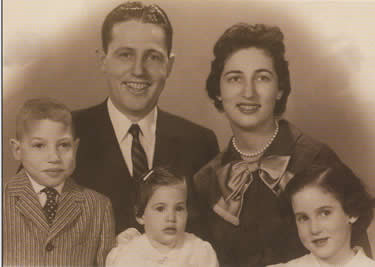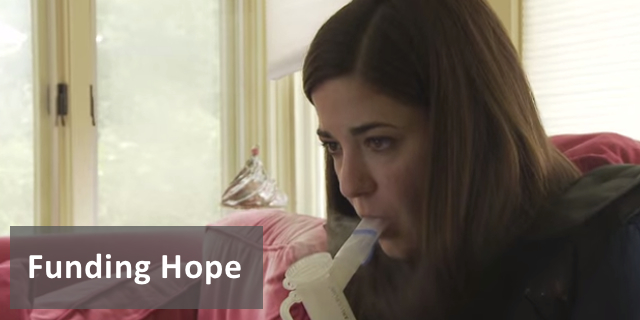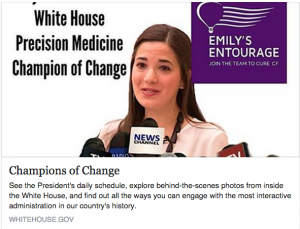Parent Activism
 In 1954, Milton and Evelyn Graub learned the devastating news that both their son and daughter, Lee and Kathy, had cystic fibrosis. They reached out to other parents, held their first fundraiser and in 1955, founded what is now the Cystic Fibrosis Foundation (CFF).
In 1954, Milton and Evelyn Graub learned the devastating news that both their son and daughter, Lee and Kathy, had cystic fibrosis. They reached out to other parents, held their first fundraiser and in 1955, founded what is now the Cystic Fibrosis Foundation (CFF).
The CFF has been instrumental in making this rare disease visible. It has funded research that, 25 years ago, found the root cause of cystic fibrosis—a genetic error in the CFTR gene on the 7th chromosome. Changes in this gene affect systems in the body that produce fluids, like the digestive and the respiratory tract. Specifically, these changes affect the production of the CFTR protein which governs salt and water flow into and out of cell membranes. Without the CFTR protein, thick sticky mucus that increases lung infections and impairs functions in a number of organs is produced. In 90% of people with CF, the pancreas degenerates and is replaced by fibrous cysts. The lungs accumulate thick mucus, and bacterial infections eventually destroy the lungs.
There are over 1900 mutations to the CFTR gene.
Partnering with Vertex since 2000, the CFF has provided $150 million for the development of products that target the genetic causes of CF. In 2012, FDA approved KALYDECO (ivacaftor, VX-770), a CFTR potentiator for people ages 12 and up. And in March 2015 the FDA expanded the original approval of KALYDECO® to children ages 2 and up.
The Cystic Fibrosis Foundation is a model of bringing strength, dedication and the power of love into advocacy for change. Because of CFF, the life expectancy of people with cystic fibrosis has gone from 2 years in 1954 to 40 years in 2015.
Yet even as the Cystic Fibrosis Foundation works for a cure, their efforts have focused on the 90% of patients with the df508 mutation. What about the others, that last 10%?
Emily’s Entourage
 For the past 30 years, Emily Kramer-Golinkoff has been the focus of teams of health care providers. “CF is an intrinsically entwined part of every single second… [of my life]…My health is part of every moment: and care is what allows me to engage meaningfully and productively in …my life.”
For the past 30 years, Emily Kramer-Golinkoff has been the focus of teams of health care providers. “CF is an intrinsically entwined part of every single second… [of my life]…My health is part of every moment: and care is what allows me to engage meaningfully and productively in …my life.”
Emily’s mutation is one of the most rare causing Cystic Fibrosis. The goal of Emily’s Entourage is to bring awareness and funding for research and drug development for the most rare mutations.
At this point, Emily has advanced-stage CF and CF-related diabetes, with only 35% lung capacity. Yet Emily works at The University of Pennsylvania’s Penn Social Media and Health Innovation Lab, having graduated with a master’s degree and clinical certification in bioethics. While living her life to the fullest, she has never been able to be with another person with CF. This is because of a little known fact that, “People with CF can pass on infections to each other with catastrophic and fatal consequences.” The mucus accumulating in their lungs contains infectious agents that can be fatal to other people with CF. “Support is vital for dealing with chronic, fatal diseases. It’s really tough when your fellow disease compatriots are your biggest threats from a cross infectious standpoint. “
To bridge this gap, Emily uses her understanding of social media. Recently, Emily has produced videos that share her life—to provide an understanding to others of how much time she must engage in treatment throughout the day.
Raising Questions
Since the 1983 passage of the Orphan Drug Act, around 220 medications have been approved for rare diseases. Forty-two percent of these have been approved in the last 10 years. What’s happening? Why is there a focus on rare diseases?
Pharmaceutical companies have realized that the Orphan Drug Act allows testing of potential medications on fewer patients, thus reducing the time it takes to do clinical trials. Additionally, the FDA provides an “expedited review,” reducing development costs even further. Governmental financial incentives are also provided, bringing the cost of development for rare disease drugs down by one-third to one-half.
For those who have been waiting for years for new drugs, the ratcheting up of production is a god-send. Yet others are beginning to question the use of resources on rare conditions, suggesting that rare diseases are competing with more prevalent diseases for limited resources.
Financing Research on the Rarest of the Rare
Then again, pitting disease against disease, patient against patient, parent and loved ones against parent and loved ones, overwhelming need against overwhelming need, seems an even greater waste of energy and resources.
In the case of Emily’s Entourage, fundraising has raised over one million dollars so far. “Those  funds go towards accelerating research with a focus on rare CF mutations. Currently we’re funding trailblazing work at UCSF that is focused on my rare mutation. We’ve been very fortunate to have wonderful researchers helping to drive Emily’s Entourage’s mission forward. The aim… is to find new treatments and ultimately achieve control/cure for everyone with CF.”
funds go towards accelerating research with a focus on rare CF mutations. Currently we’re funding trailblazing work at UCSF that is focused on my rare mutation. We’ve been very fortunate to have wonderful researchers helping to drive Emily’s Entourage’s mission forward. The aim… is to find new treatments and ultimately achieve control/cure for everyone with CF.”
For Emily and her family, this is a no-brainer. Emily explains, “The truth is that life is fragile and tenuous for everyone, but I think those of us with CF and other life-threatening illnesses live with an acute awareness of this reality every single day.”
Your Thoughts?
How do you feel about a communication environment that pits disease against disease? What are your thoughts about the use of resources on rare conditions? Can we change the discussion/debate to benefit all? What do you think?
Update: Congratulations!
Emily has been named one of The White House Precision Medicine Champions of Change 2015 for her work on raising money for research on treatment and cures for people with nonsense Cystic Fibrosis mutations! She will meet the President and speak at the White House July 8th. Congratulations Emily!






